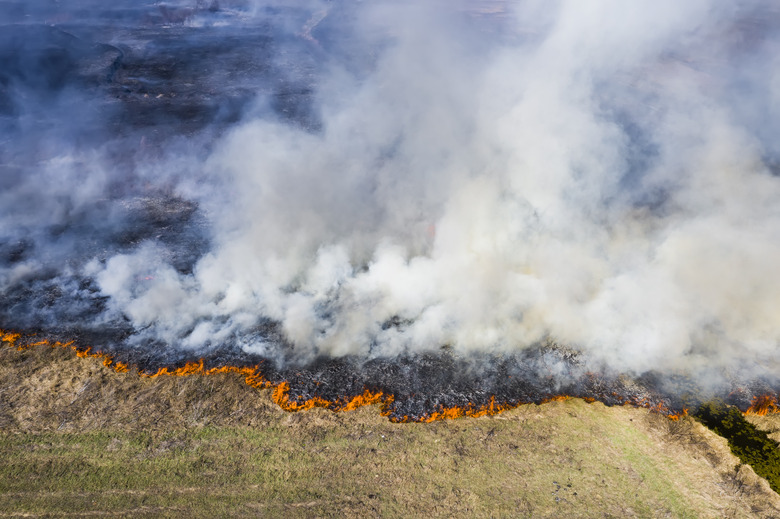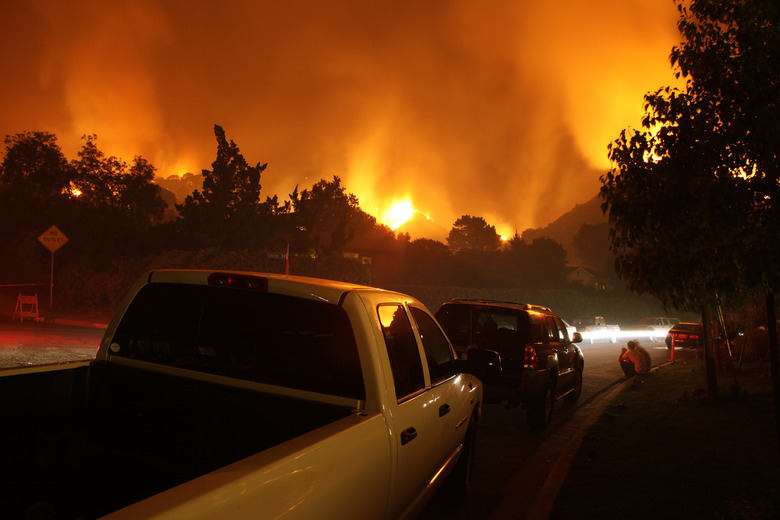8 Tips To Keep Your Home — And Your Family — Safe During A Wildfire
We may receive a commission on purchases made from links.
Learning critical wildfire safety tips will help you keep your family safe when a wildfire comes your way. You'll need to develop an evacuation plan to ensure your family's safety, but a bit of preparedness may also help you reduce fire damage to your home.
1. Understand the Risk of Wildfire
1. Understand the Risk of Wildfire
One of the most important ways you can protect your family members from a wildfire is to understand how they work and where they typically occur. Wildfires can happen anywhere when conditions become hot and dry, sapping vegetation of its natural fire-retardant moisture. All it takes to start a wildfire in these conditions is a spark from a poorly attended campfire, discarded cigarettes, fireworks, malfunctioning electrical equipment or a lightning strike.
Once the wildfire starts, it travels anywhere from six to 14 miles per hour in whatever direction the wind blows. This means wildfires can change course in an instant and that the average person can't outrun them. Depending on how congested the roads become, you may not be able to outdrive a wildfire either. In addition, there's a significant danger of succumbing to smoke inhalation before the flames actually arrive.
An evacuation plan is critical so that you know how to leave the area quickly and safely. In the grand scheme of things, your life is more important than your home and belongings. Just get out. With that said, you may be able to minimize damage to your home with a few strategies if you leap into action while the fire is still several hours away or follow some smart maintenance tips throughout the year.
2. Develop Your Wildfire Evacuation Plan
2. Develop Your Wildfire Evacuation Plan
Know when to leave, which evacuation routes to take, where to go and what to bring with you in the event of a wildfire. Sign up for emergency alerts through apps offered by the Federal Emergency Management Agency or your local news station. When an evacuation is recommended, go. Don't wait for evacuation orders or for someone to knock on your door. By then, the risk is severe, and it may be dangerous or impossible to leave safely. There's also no guarantee that anyone will knock on your door.
Wildfires can come from any direction, and smoke can make visibility difficult. Therefore, it's a good idea to become very familiar with every route out of your neighborhood and toward your preferred shelter, hotel or other safe meeting place. Try to keep a full tank of gas in your vehicle so your car doesn't break down on your way to safety.
Store a first-aid kit, water, nonperishable food, a change of clothes, personal hygiene products, a phone charger, pet food and supplies, extra cash and copies of important documents in your vehicle so that you're ready to go at all times. If there are any items in your home that you would be devastated to lose, consider placing them in a fireproof safe or packing them ahead of time to take with you. Finally, keep all of your family's prescription medications and other must-have health items in a central location so you can easily scoop them into a bag when it's time to leave.
3. Prep Your Home
3. Prep Your Home
If you're on "fire watch" but haven't yet received an evacuation alert, go ahead and prep for a fire by moving furniture into the center of the room. Remove curtains from windows too. This slows the spread of the fire once it hits your home and may give firefighters a chance to kill the flames before they consume the entire structure. Even if your home's exterior is made of fire-resistant materials, it might still get hot and transmit enough heat to flammable materials, like curtains, to start a fire inside your home.
Keep the air conditioning turned off and all doors and windows closed to reduce airflow, which would also fuel the fire. Close attic and basement vents, pet doors, etc. for the same purpose. Move all outdoor furniture, grills, sun shades or anything else that is flammable as far away from your home as possible. In other words, do not give the fire a convenient stepping stone to your home.
Once you do decide to evacuate, shut off the main gas line to your home following instructions from your gas company. Leave indoor and outdoor lights on to help firefighters see your home despite smoky conditions, and consider leaving your home unlocked to help firefighters enter quickly if needed. If that makes you uncomfortable, prop a ladder against the front of your home to allow firefighters to climb to your roof.
4. Practice Your Evacuation Plan
4. Practice Your Evacuation Plan
If you have small children or pets, practicing your evacuation plan can ensure everything goes smoothly when it counts. Give everyone a job, whether it's to help a child put on shoes, grab the cat carrier or simply get to the car and buckle up. Because the wind may blow smoke and embers toward you, consider preassembling some evacuation gear for everyone to put on, such as a respiratory mask, a long-sleeved and hooded fire-retardant jacket and even goggles.
Practice leashing up the dogs, packing up all other critters and ensuring there's enough room for everyone in the car. Because cats in particular like to hide during stressful situations, consider placing the cat in a carrier or in a small room, like the bathroom, well in advance. If you have horses or other livestock, practice loading them into the trailer to avoid stubborn refusals on the big day. Make sure you hitch the trailer in advance so you can load up and go.
5. Know What to Do If You Can't Evacuate
5. Know What to Do If You Can't Evacuate
Wildfires move fast. If you cannot get out in time, it's best to stay inside with your face down and as far away from exterior walls as possible. Cover yourself with a wool blanket to protect yourself from flames and embers and breathe as close to the floor as possible. Call 911 and inform the operator of your location. Your home should provide some protection from radiant heat and flames long enough for the fire to pass through the area. It will be loud and very hot. As soon as the noise dies down, find the safest exit and open the door with the help of your wool blanket for protection.
If you're already on the road, park on a road or somewhere else with no vegetation. Lie on the floor of the vehicle under wool blankets, breathing as close to the ground as possible. In the event you get caught in the middle of a wildfire with no shelter available, you need to lie face-down in an area filled with rocks or dirt. A low spot is preferable. Cover as much of your body with soil as possible.
As scary as it sounds, you need to plan for this scenario. In your home, you'll want wool blankets for protection and a fire extinguisher, containers of water and/or bags of sand to help you put out any flames that block your exit. Keep wool blankets in your car as well.
6. Maintain Your At-Risk Property
6. Maintain Your At-Risk Property
Are you a homeowner or renter in an area with a high risk of wildfires? California, Texas, North Carolina, Georgia and Oregon have historically experienced the greatest number of acres burned due to wildfires. However, the states with the greatest number of properties at risk of wildfire damage include California, Texas, Colorado, Arizona and Idaho. To better understand your risk, you can also explore tools like the real-time interactive wildfire map on FireWeatherAvalanche.org.
High-risk homes need preventative maintenance before a wildfire even starts — often referred to as creating defensible space. For example, you'll need to regularly clean up and clear out dry vegetation at least 30 feet away from your home in all directions. This includes dead tree branches. You'll also need to store firewood and propane tanks 30 feet away from your home and keep your gutters and roof clean of debris like twigs and leaves.
Depending on the size of your property, you might not have control over all the vegetation within 30 feet of your home. Collaborate with your neighbors to ensure they perform the same maintenance tasks on their properties as well. Anything that can slow the spread of the fire gives firefighters more time to control the blaze around your property if possible.
7. Landscape Smarter for At-Risk Properties
7. Landscape Smarter for At-Risk Properties
Wildfires can be stopped if there's no fuel. A common wildfire-fighting tactic involves getting ahead of the fire and removing flammable materials to corral the blaze. Once the fire burns through the available fuel, it fizzles out. You can use the same tactic by surrounding your home in hardscaping.
Concrete, landscaping rocks, sand and bricks are all examples of nonflammable hardscaping building materials. Surround the entire home in hardscaping from the edge of the home to a radius of at least 30 feet. Before evacuating, you'll need to move anything flammable off the hardscape to allow it to work as a fire barrier. Keep in mind that wildfires can also threaten a home with embers, tall flames blowing in the wind and intense radiant heat, so it's critical to combine this tactic with other wildfire safety tips for best results.
Admittedly, hardscaping isn't for everyone. A lawn or garden can slow down a fire but with one caveat: It has to be well-watered. Dry grass will burn easily, but the moisture content in green vegetation makes it difficult to burn (just think about how frustrating it is to start a campfire with fresh-cut wood). Still, wildfires can reach over 1,400 degrees Fahrenheit, and it's difficult for any living thing to survive that intensity. Even a green lawn will be toast when exposed to such strong temperatures, but its presence does save firefighters some time.
8. Add Fire-Resistant Construction Materials
8. Add Fire-Resistant Construction Materials
A great way to protect your home from wildfires is to build it with fire-resistant construction materials inside and out, but even adding fire-resistant roofing and siding to your existing home can make a difference. For example, a home with a concrete pad foundation, stucco siding and a metal roof will be more fire-resistant than a home built on wooden piles with clapboard siding and asphalt shingles.
Look for construction materials marked as class A, which is awarded to materials most capable of slowing the spread of flames. Even the glass in your windows should be a class A material. Otherwise, the glass will crack in high heat and allow the flames to enter the home. Another weak area in your home might be wooden eaves that aren't enclosed in metal.
Note that it's virtually impossible to build a 100 percent fireproof home. Even if it were possible, you'd still want to evacuate. If evacuating is a poor option, such as if you live in a rural area with only one way out, you could even explore the possibility of installing an underground fireproof bunker.
References
- Cal Fire: Pre-evacuation Preparation Steps
- Surviving Wildfire: Fire Ratings for Construction Materials
- Insurance Information Institute: Facts + Statistics: Wildfires
- Verisk: Verisk Wildfire Risk Analysis
- Forbes: The Terrifying Physics Of How Wildfires Spread So Fast
- Farmers Insurance: Wildfire Defense To Help Your Home
- Frontline Wildfire Defense System: Fire-Resistant Building Materials & Home Hardening Techniques


